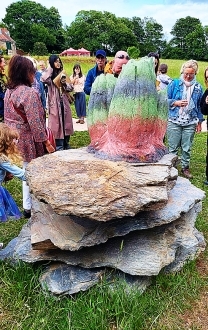Depicting a sea creature at a garden in Devon
DESPISED BY MARINERS whose boats are fouled by these creatures that attach themselves firmly to the hulls of vessels, they are important in the seawater eco-systems. I am referring to barnacles, which are arthropods of the subclass Cirripedia. The mature barnacle attaches itself to surfaces including boats, seashells, sea creatures including whales, and rocks, using an incredibly strong glue that they secrete. Once stuck in place, they feed by filtering the water through their bodies, extracting plankton from it. Thus, barnacles assist in the purification of seawater. For those who are concerned with ecological matters, barnacles are a useful indicator of water quality in coastal environments.

Our daughter, who is the curator at UP Projects, an organisation that commissions and executes public art works, has been involved in producing a sculpture, “I travelled 66 million years to be with you and then you came”, created by the artist Anne Duk Hee Jordan. It was unveiled on 4 June 2025. The sculpture is a depiction of the bodies of barnacles, greatly enlarged, perched on a pile of slate stones on which shapes of fossils have been carved. The barnacles are sculpted in porous materials that, like real barnacles, filter and purify water that passes through them. As UP’s website explained, the barnacle forms:
“… are made from materials with water-filtering properties, including Roman concrete, a plant-based version of activated charcoal known as biochar, shell fragments, zeolite minerals and iron oxide …”
By using these materials, the barnacle sculptures not only resemble the creatures’ forms but also their filtration functions.
The sculpture is being displayed in the garden of A La Ronde, a curious eighteenth-century house near Exmouth in Devon for a few months. Maintained by the National Trust, this (almost circular) building has sixteen sides and a central octagonal lightwell. It was built in 1796 by two cousins, Jane and Mary Parminter. With fine views of the River Exe and its estuary, the eccentrically designed house is filled with curiosities collected by the Parminters. These objects include many natural items such as seashells, bird feathers, fossils, bones, and rocks. No doubt some of these specimens have the shells of dead barnacles attached to them.
It is quite appropriate that Duk Hee’s modern sculpture, which simultaneously celebrates the importance of barnacles and purifies water falling on it, has been placed in the garden of a house once owned by two ladies who, judging by their extensive collection of seashells and other natural objects, had a great interest in the environment in which they lived. The artist’s creation serves as an object on which to concentrate while contemplating the importance and fragility of the eco-system that supports life as we know it.



